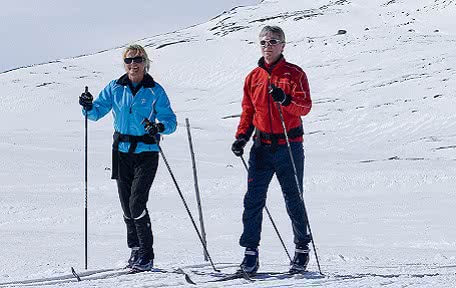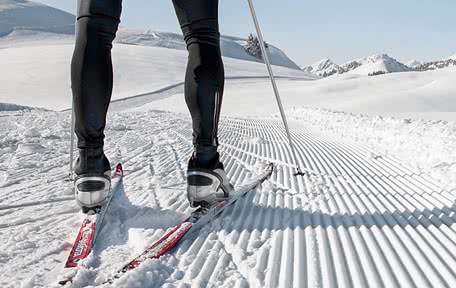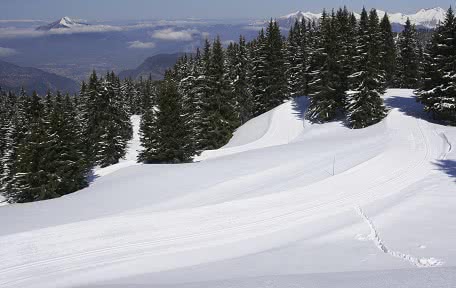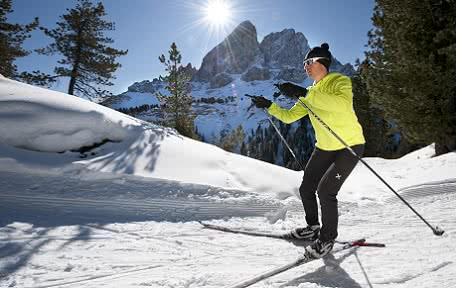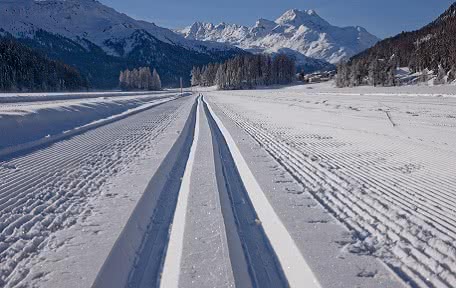Cross country skiing
Known as langlauf in Austria, ski de fond in France, and sometimes nicknamed skinny skiing, this winter pastime comes under many titles, but for most it’s simply Nordic skiing – a nod to its origins – or good old fashioned cross country (XC for short).
Around far longer than standard downhill skiing, this form of ski touring is becoming more and more accessible across the globe, and its popularity – as a fun, free, fresh way to get fit and closer to nature – is fast increasing.
What is cross-country skiing?
Fans of regular alpine skiing will spot that with XC, only the front of the boot attaches to the ski, leaving the heel unbound and free for movement and control. Different to the rush of a downhill descent, the thrill here comes from propelling yourself across snowy terrain to get from A to B.
This endurance sport uses the front and insides of your thighs (instead of the backs), and can be relaxed or competitive: most opt to make a day of it, traversing across a smooth incline and absorbing incredible scenery, before packing in the carbs at lunch and looping back home.
Types of cross-country skiing
The two main forms of cross country skiing are classic and skate. Classic is the original method, developed over millennia in the Nordic countries. Skate came about in the eighties but soon became a preferred method for those seeking a more fast-paced pursuit.
Classic cross-country Skiing
This is the less intense method, and involves keeping the skis straight and moving them parallel to the direction of travel. It can be done at any pace, letting you find a rhythm that suits you and the surroundings. Weight’s transferred onto one leg at a time using a kick and glide motion - when full weight is applied to one ski, it grips the snow and allows the process of pushing off and swooshing onto the other ski. As this foot pushes off, the unattached heel leaves the ground, and the weight transfer powers the forward motion. The skis used are long and built with a slight arch, with a central wax or grip zone on the bottom of each one.
Ski poles help with the pushing motion, and move opposite to the skis (just like your arms do when you walk or run). This pole movement’s why the classic form is often referred to as diagonal stride. Double poling refers to the use of both poles which can be handy for beginners, as they act to aid steadiness. Combining this technique with a single alternative kick is how many conquer the challenge of a hill, and it also works wonders for simply propelling weary limbs across flats, or ploughing through thicker snow.
Cross country trails
Trails or loipes are the routes laid out for classic and skate skiers, some taking you to high altitudes, others skirting lakes or leading through forests. These mostly come in the form of loops, though you can come across straight trails now and then. The ones for skate skiing are groomed, while parallel tracks are carved into the snow for classic skiers. Some routes feature both alongside each other. In bigger resorts, and ones nearer the arctic circle, floodlit loops let you enjoy some action after dark. The trails are graded for different difficulties, with green and blue being the easiest, red for medium/intermediate and black for the trickiest.
The best Nordic ski resorts
It’s hard to find a ski resort that doesn’t offer something for cross country skiers these days, but some are superior to others with more trails, specialist shops and indoor facilities. It comes as no shocker that Norway has amazing offerings for Nordic skiers, with Geilo clocking up a whopping 550km of snow sure trails usually open from October to May. Finland’s another world-leader, home to resorts like Ylläs which has 330km of terrain taking you through winter wonderland wilderness. Kitzbuhel and Seefeld are Austrian favourites: Kitz’s surrounding mountain range has 500km of terrain, while Seefeld’s trails total 279km and host World Cup and Olympic events.
History of Nordic skiing
This is the oldest type of skiing there is, used for thousands of years by Scandinavians as a means of getting around and going about their daily routines in the deep mid-winter. It started evolving into a sport in the 18th century, when Norwegian army ranks would race amongst each other competitively. The men’s cross country event featured in the first ever winter Olympics in 1924. The classic style held top spot until the eighties, when American Bill Koch won the 1982 World Cup title, creating a love affair with the new skate style. Since then the competition has been hot, and divisions are labelled classic or freestyle, while the Pursuit combines the two.
Skate Cross-country Skiing
This style only popped up in the eighties, and has made waves across the cross-country scene. The movement’s similar to roller-blading or ice-skating - skis are moved in a V shape across packed pistes and sharp hills. One ski uses the weight of the skier on its inside edge to switch to the other ski, generating power. Another popular technique is the two-skate stride, which is a go-to for some when it comes to cruising and the odd downhill descent. For every two strides, there’s a double pole push, which, mixed up with a one-strider is the real-deal for high speeds and head turns. Since the movement is so different to the classic style, skis are shorter and cheaper, without the wax pocket.
Uphill XC techniques
Thanks to the herringbone style, hills are no longer unwelcome obstacles. Using a V formation, the skis are moved in a stepping motion, with the edge of them used for balance and pushing off for the next step. A top tip for mastering this is to try it at a walking pace first, before working up to a faster stride. Trusty poles are then planted alternately towards the bottom of the V for extra stability and a helpful upward push.
Whether you’ve got the herringbone down to a T (or V!), or just don’t get on with it, the offset technique (aka paddling or V1) is another friend when it comes to hills. Keeping the all-important V shape, the poles are planted at the same time as one ski lands on the snow, giving you three points of contact with the ground at once to propel you upwards.
Who can do cross-country skiing?
Whether old, young, fit or… less fit, anyone and everyone can enjoy a spot of skinny skiing. Those with a competitive edge will embrace the whole host of competitions that take place around the world – most notably the FIS World Cup and Olympics. Making a class appearance in both are the biathlon races, which are just as much fun to witness as they are to take part in – individuals stop at firing ranges along the distance route, combining speed and accuracy. Always worth a watch, or even a dabble, are the ski races that World Loppet Skiing put on; don your skis and jump into the community with a dash down the race track, or watch the elite fight neck and neck for the top place.
But, it’s not all about the gold and glory; many people make an annual trip to snowy climes for a vacation made up of purely cross country. Thanks to growing interest, resort’s now have instructors on hand to show newbies the way, with some building dedicated centres. Unlike downhill skiing, you don’t need to buy a pass to access Nordic slopes, so there’s no excuse for not giving it a go!
Top image © Seefeld tourism
Cross country skiing FAQ:
Loads of places! The UK ski holiday industry is geared more toward alpine skiing, but you’ll be able to find Nordic skiing almost anywhere there’s snow. Austria, Switzerland and Scandinavia lead the way in cross country skiing. If you’re itching to work on your skating or classic style the best resorts to try are Seefeld, Kitzbühel, Mayrhofen, Zell Am See, St Johann, St Moritz, Davos, Beitostolen, Geilo or Levi.
In France: La Plagne, Chamonix
In Austria: Seefeld, Kitzbuhel, Mayrhofen, Zell Am See, St Johann
In Italy: Kronplatz
In Finland: Yllas, Levi, Saariselka
In Norway: Beitosteolen, Geilo
In Switzerland: St Moritz, Davos
If your resort has cross country trails, it’s pretty much a given that there’ll be somewhere to teach you how to use them. Often, we can’t pre-book cross country lessons, unlike alpine skiing, but we can advise on where to find them. In the Tirol, for example, there are lots of ski schools that can introduce you to the wonders of langlauf.
A big decision to make is whether to go ‘classic’ style or ‘skating’ style. Each technique requires different gear, and you’ll want to consider which fits your needs best.
Classic style is an easier start point for most and less demanding on the body, whereas skating is a more dynamic, physiologically intense movement with a higher top-end speed. For both styles, you’ll want to dress for mobility and warmth - the downhill salopettes and thick jacket might hinder, not help!
Just like their alpine counterparts, cross country trails are graded blue, red and black for their difficulty.
Many people choose to learn the basic skills here in the UK without snow, and you can find resources on where to learn X-country on wheels at rollerski.co.uk
Cross country skiing is very accessible (no steep slopes or drops to contend with), but we would always recommend lessons before embarking on a new pursuit. You might think it’ll be simple because you can ski downhill and cross country is ‘safer’, but your cruciate ligament will thank you for learning how to stop properly and do an elegant emergency fall.
Nordic skiing is popular in European and Scandinavian ski resorts, especially Austria and Norway, so you shouldn’t struggle to find a great place for lessons. One thing you do need is fitness - especially if you want to learn the skating style.
The Huntley outdoor and Nordic centre in Aberdeenshire will take you on trails through Clashindorrack Forest and is a purpose-built Nordic facility so you can learn to roller ski too. There’s also the Glenmore trails in Aviemore.
Hire shops often offer cross country ski gear so ask us when booking your holiday. We can sometimes arrange cross country hire via our suppliers or advise on the best way to hire (e.g. contacting the tourist office or a specific shop).
You can wear a helmet when cross country skiing, but some find it uncomfortably hot given the intensity of the exercise. The speeds you’re working at are generally lower, but protection should never be underestimated. As crosscountryski.info point out, even though the hills might not be as steep as alpine skiing, you’re still going to be doing them. Ultimately, this will come down to preference if it’s not mandated by the resort or ski school.





